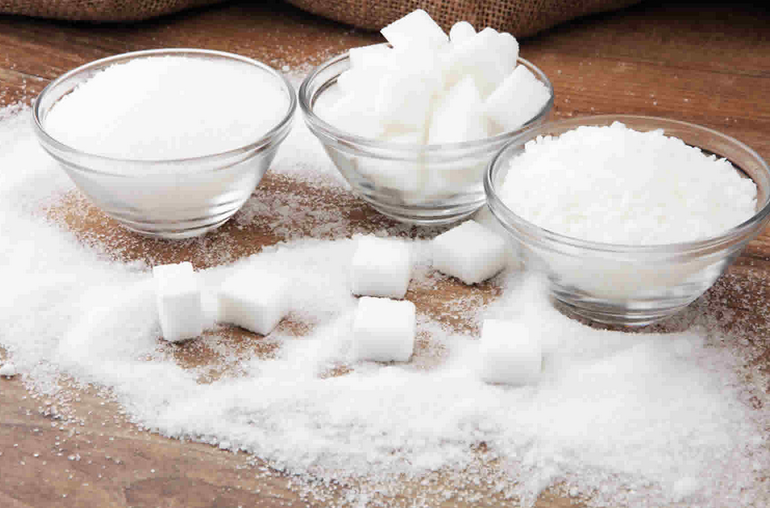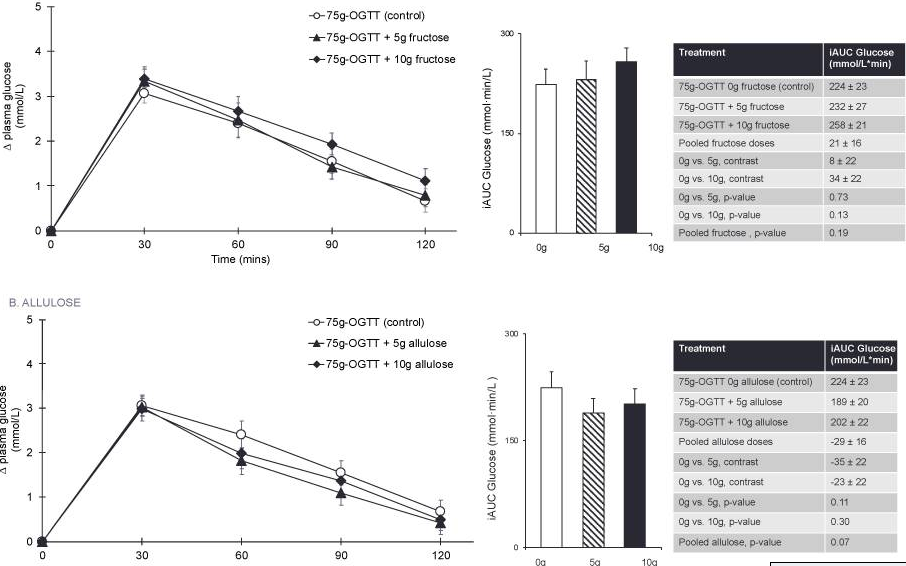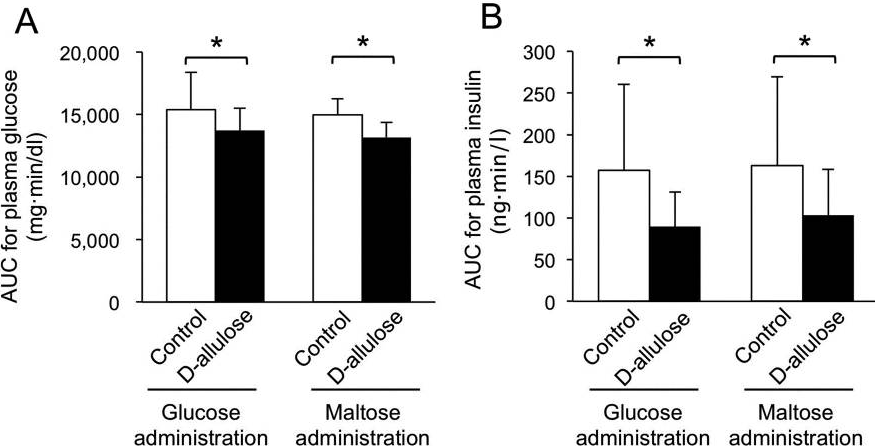Allulose (sometimes D-psicose) is by-far one of the best ways to add sweetness to home-cooked meals in a healthy and low-calorie way. As an epimer of fructose, it has been steadily gaining popularity within the last few years, and not without good reason! Allulose is not only nearly calorie-free, but also decreases blood glucose levels with meals, and seems to have a wide range of potentially beneficial effects.This post is a short summary of why allulose is so appealing over sugar and other sugar substitutes.

Overview of Allulose
Allulose is found naturally in wheat, figs, raisins, maple syrup, and molasses, although in relatively trace amounts. It has around 10% the calories of traditional sucrose and can be manufactured from fructose. It’s around 70% as sweet as sucrose (regular sugar), but has a similar taste and feel, which is a large factor behind why it makes a great substitute (or partial substitute) for baking or dissolving into things. The taste of Allulose has a more natural and relaxing quality than some other sugar-replacement options such as xylitol and erythritol, which are both sugar alcohols, but generally have a ‘cooling effect’ (often likened to the aftertaste of consuming mint, which allulose conveniently lacks).
Allulose is also an actual sugar (not a sugar alcohol or other compound), and has similar browning properties to sucrose via the Maillard reaction. One downside to mention is that it does seem challenging to keep some styles of baked goods crunchy with allulose as the only sugar; while it definitely seems to be one of the best options for sweetening drinks, yogurts, ice creams, cakes, and so on, it may not be the best option for super-crunchy cookies (although can make great softer ones!). This seems to be due to allulose not crystallizing when it cools, its ability to hold more moisture, and that it is more soluble in liquids than sucrose; hence it being a great fit for drinks, sauces, and spongy baked goods.
Allulose was designated as GRAS by the FDA in 2019, so is still relatively new to the market compared to many other sugar substitutes, although has been gaining significant popularity for the short period that it has been available for general usage in foods. I’m sometimes now able to find allulose for sale in a supermarket or included in a sweet good (and it is also now being used in products such as Soylent), although its usage is still a small fraction to that of sugar and corn syrups. It can easily be purchased on Amazon for around $10 per lb (regular sugar is generally closer to $1-2 per lb, so it is quite a bit more expensive if you happen to use very large amounts of sugar).
What Sets Allulose Apart
Why might we want alternative sources of sweetness from sucrose to begin with? Although much has been said about the ways sugars are (in some cases) potentially harmful, it seems reasonable to posit that there are two qualities of a diet with high sugar content (remember, this means any typical western diet!) that are undesirable: firstly, the high caloric content of sugar, which makes over-eating significantly easier and therefore contributes to obesity, and secondly, the effects of sucrose on blood glucose levels and thus insulin resistance, which contributes to diabetes and metabolic syndrome.
As we would hope from an alternative to sucrose, allulose doesn’t cause an increase in blood sugar. The reason for this is that it is not absorbed and digested by the gastrointestinal tract, but rather processed by intestinal bacteria. For the most part this is a good thing, and is what enables allulose to both be low-calorie and to not be converted to glucose in the blood stream. The downside of this is that for some people, especially if consumed in large enough quantities, it can cause mildly discomforting side effects such as flatulence, subpar digestion, and abdominal discomfort. This is much more likely to occur if you, for example, eat an entire batch of allulose cookies by yourself (who would do such a thing..!?), rather than simply use it to sweeten a drink or a snack. While I haven’t experienced anything negative myself, everyone is certainly very different when it comes to food.
But, it gets much better than this! Allulose not only doesn’t increase your blood sugar, but actually decreases it! It does this by inhibiting alpha-glucosidase (along with several other similar enzymes), which is an enzyme that breaks down starches and disaccharides into glucose (i.e. causes carbohydrates to lead to blood glucose spikes). Other well-known inhibitors of alpha-glucosidase include acarbose, a popular and simple diabetic drug which significantly extends lifespan in mice and has the exact same potential side effect profile as large allulose doses (and in my opinion is probably very good for most people to be taking, perhaps extending human lifespan via the same mechanism of action as in mice), and sweet potatoes (source, another source). Thus, adding allulose to meals that contain carbohydrates will result in less of a blood glucose spike than if allulose had been excluded.

There’s now quite a few studies showing this in humans (and dogs and mice!), with allulose consistently attenuating the postprandial glucose levels both in diabetic and regular adults (effect sizes are often larger in pre-diabetic and diabetic individuals, as is often the case here).

But wait, there’s more!
Several studies also appear to show lower plasma triglyceride levels and improved lipid profiles (perhaps via the lowering of hepatic lipogenic enzyme activity, maybe involving SCARB1, but probably many others as well), decreased feeding (perhaps via agonizing glucagon-like peptide-1), enhanced fat oxidation, and a reduction in inflammation related to adipokine and cytokine plasma levels (one paper claims this is partially due to down-regulating gm12250 in mice, but if this applies to humans it may be a side-effect of more upstream metabolic changes more so than specific agonism/antagonism, although as is the case with most foods, things get absurdly complicated very quickly with the amount of pathways involved).

It’s worth noting that several of the above studies (particularly ones that attempt to hone in on specific mechanisms of action) are in mice, and in fact, we could go much further if we want to look at mice; it’s trivial to find many more potentially favorable results such as “Not only metformin, but also D-allulose, alleviates metabolic disturbance and cognitive decline in prediabetic rats” or “D-allulose provides cardioprotective effect by attenuating cardiac mitochondrial dysfunction in obesity-induced insulin-resistant rats“. Although there is less (and sometimes conflicting) evidence for e.g. improved lipid profiles in humans, there is certainly more than sufficient evidence of allulose’s effect on reducing blood glucose levels and overall calories consumed, from which we would naturally expect many other beneficial effects to follow. Searching for allulose on pubmed results in a wonderful selection of studies showing very consistent outcomes in this area, and it thus seems plausible that, at the very least, we would see significant reductions in diabetes and obesity if allulose were to be more widely adopted in consumer food products.
Conclusion
In general it seems like replacing sugar with allulose will result in fewer calories consumed, a lower risk of obesity, lower blood glucose (average and area under the curve, sometimes peak) levels and thus improved insulin resistance and a lower risk of diabetes and metabolic syndrome, and potentially some other beneficial effects (which may or may not apply in humans, but if allulose improves your diet and lowers your food intake, I would not be surprised to see improved lipid profiles and a reduction in inflammation, even if entirely for indirect reasons, e.g. cooking at home with allulose instead of purchasing processed foods from the store. It’s also worth noting that while some of these benefits are a direct result of allulose consumption, many are also partially from a reduced intake of sugar and calories – similar to how cutting down on your sugar intake would offer many benefits).
It’s quite possible that if a notable fraction of other sugars in our diet were to be replaced with allulose, the amount we would gain both in QALYs and dollars saved via the resulting reduced healthcare burden would be extremely favorable. Allulose is still relatively new to the market, and as it is also much more expensive than sugar or corn syrups, its future market penetration may be relatively limited by consumer preferences. Regardless of its presence in our broader food ecosystem, you can start experimenting with it yourself today! (Amazon search results page link, in case this saves you 10 seconds)
I usually use allulose to sweeten drinks, greek yogurt, and sometimes add it to sauces or baked goods in small quantities. I’m also pretty interested in glycine and think it may be something that most of us should be having a lot more of as well (some notes on this in the glycine section on my supplements page), but consider it outside the scope of this article for now. Lastly, if the idea of significantly reducing the glycemic index of your meals is appealing, I strongly suggest looking into acarbose – it is a much stronger inhibitor of alpha-glucosidase, well-tolerated, and also relatively cheap.
If you enjoyed this article you might also enjoy my supplements page which discusses many other ingredients and drugs that I find interesting with respect to longevity. Feel free to reach out with any comments or corrections via any communication method on my about page, thanks for reading!